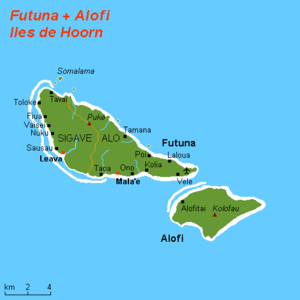Hoorn Islands


with Futuna Island in the northwest
The Hoorn Islands (also Futuna Islands) are one of the two island groups of which the French overseas collectivity (collectivité d'outre-mer, or COM) of Wallis and Futuna is geographically composed. The aggregate area is 115 km², and the population 4,873 (census of 2003).
History[]
The archipelago was named by the Dutch navigators Willem Schouten and Jacob Le Maire, who, in 1616, became the first Europeans to visit the islands. They named it after the Dutch city of Hoorn, from which their expedition had started.
Geography[]
Geographically, there are two islands:
- Futuna Island (in the northwest) (83 km², pop. 4871)
- Alofi Island (in the southeast) (32 km², pop. 2)
Administratively, the Hoorn Islands encompass two of Wallis and Futuna’s three royal chiefdoms, namely:
- Tu`a (Alo), which comprises Alofi Island and the eastern part of Futuna Island (area 85 km², pop. 2993)
- Sigave (Singave), which comprises the western third of Futuna Island (area 30 km², pop. 1880)
(The third royal chiefdom is Uvea.)
See also[]
- Wallis Island (Uvea)
References[]
Coordinates: 14°16′57″S 178°08′59″W / 14.28250°S 178.14972°W
- Islands of Wallis and Futuna
- Archipelagoes of the Pacific Ocean
- 1616 in the Dutch Empire
- Maritime history of the Dutch Republic
- Non-metropolitan France geography stubs
- Oceania geography stubs
- Wallis and Futuna stubs


